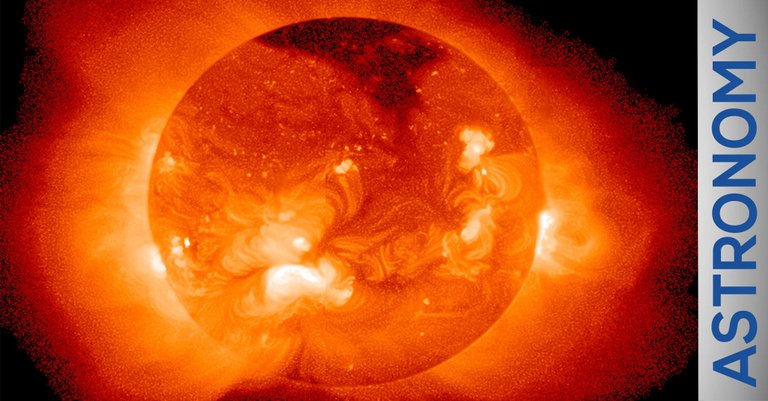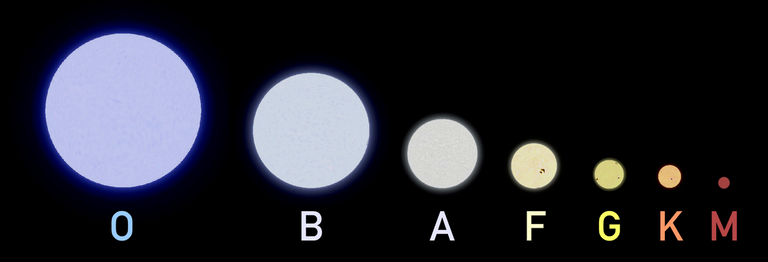
By NASA Goddard Laboratory for Atmospheres and Yohkoh Legacy data Archive [Public domain], via Wikimedia Commons]
English
For 4.6 billion years, our Sun has been the life-giver for all life on Earth and will most likely do so for at least another one billion years. She was created by the gravitational collapse of matter within a large molecular cloud and grew to a star that is now 109 times larger and 330,000 times more massive than the Earth's diameter. But at some point her life will also end when she has used up her hydrogen and can no longer sustain inner nuclear fusion. But what exactly will happen to her after that has long been a hot topic among scientists.
Deutsch
Seit 4,6 Milliarden Jahren ist unsere Sonne der Lebensspender für alles Leben auf der Erde und wird es sehr wahrscheinlich für mindestens weitere eine Milliarde Jahre tun. Sie wurde durch den gravitativen Kollaps der Materie innerhalb einer großen Molekülwolke geschaffen und wuchs zu einem Stern, der heute 109-mal größer und 330.000 mal massereicher als der Erddurchmesser ist. Aber irgendwann wird auch ihr Leben enden, wenn sie ihren Wasserstoff verbraucht hat und im inneren die Kernfusion nicht mehr aufrecht erhalten kann. Aber was genau danach mit ihr passieren wird, war lange ein heißes Thema unter den Wissenschaftlern.
Star categories - By User:Omnidoom 999 CC BY-SA 3.0, from Wikimedia Commons
Our sun is one of the main series stars. These are suns that release their radiation power through hydrogen. As a rule, a main sequence star collapses from a red giant to a white dwarf as it dies, forming a gas and dust ring that still shhines. This phenomenon is also referred to as a planetary nebula. The theory is that a star with less than twice the mass of such a sun would leave behind a too-weak planetary nebula that would not be visible and would therefore be out of the question for our sun.
Unsere Sonne zählt zu den Hauptreihensternen. Das sind Sonnen, die ihre Strahlungskraft durch Wasserstoff freisetzen. In der Regel ist es so, dass ein Hauptreihenstern beim sterben von einem roten Riesen zu weißen Zwerg kollabiert und einen Gas- und Staubring bildet, der noch nachglüht. Dieses Phänomen wird auch als planetarer Nebel bezeichnet. Die Theorie besagt eigentlich, dass ein Stern der weniger als die doppelte Masse einer solchen Sonne besitzt, einen zu schwachen planetarischen Nebel hinterlassen würde, der nicht sichtbar wäre und das somit für unsere Sonne nicht infrage käme.
credit By NASA [Public domain],
An international team of astronomers now finally wants to find out how our sun will actually die. According to their study, in about 5 billion years our sun will begin to inflate to 250 times her current size to become a red giant that will devour Mercury, Venus and our earth. In about ten billion years, she will probably collapse without an explosion and throw away much of her shell as a faint planetary nebula, leaving only her core as a white dwarf in the end.
Ein internationales Team von Astronomen will jetzt schließlich herausgefunden haben, wie unsere Sonne tatsächlich sterben wird. Laut ihrer Studie wird sie in etwa 5 Milliarden Jahren beginnen, sich auf das 250-fache ihrer derzeitigen Größe aufzublasen, um ein roter Riese zu werden, der Merkur, Venus und unsere Erde verschlingen wird. In etwa zehn Milliarden Jahren wird sie wahrscheinlich ohne eine Explosion zusammenbrechen und einen großen Teil ihrer Hülle als schwachen planetarischen Nebel wegwerfen, so dass am Ende nur ihr Kern als weißer Zwerg übrig bleiben wird.
a planetary Nebula - By Bruce Balick (University of Washington), Vincent Icke (Leiden University, The Netherlands), Garrelt Mellema (Stockholm University), and NASA/ESA [Public domain], via Wikimedia Commons
With their new model, the scientists were now able to confirm that our sun - despite the low mass - expect this fate, because apparently the previous models had underestimated the heat-colored stars. Their simulation showed, however, that the star core heated three times faster after ejection of the shell than previously thought. Thus, stars like our Sun, which are relatively less massive than general main-sequence stars, can bring their ejected shell to light - albeit weaker.
Mit ihrem neuen Modell konnten die Wissenschaftler nun bestätigen, dass unsere Sonne - trotz der geringen Masse - dieses Schicksal erwarten wird, denn offenbar hatten die Vorgängermodelle die hitzegefärbten Sterne unterschätzt. Ihre Simulation zeigte jedoch, dass der Sternkern nach dem Auswurf der Schale dreimal schneller erwärmte als bisher angenommen. Somit können Sterne wie unsere Sonne, die relativ masseärmer sind als generelle Hauptreihensterne, ihre ausgestoßene Hülle ans Licht bringen - wenn auch schwächer.
credit By NASA [Public domain]
"When a star dies, it throws a mass of gas and dust - called a shell - into space,"
says co-author of the study Professor Albert Zijlstra from the University of Manchester and then he explains:
"This triggers the nucleus of the star at the time when the fuel goes out in starlight, finally shuts off and eventually dies, then the hot core makes the ejected shell bright for about 10,000 years - of course too short for astronomical conditions - and that it's what makes the planetary nebula so bright, some are so bright they can be seen from extreme distances like tens of millions of light years, and the decayed star itself, which is then a small white dwarf, is too dark to see to be seen."
Thus, our sun, according to the latest findings, now counts among the lowest mass stars, which are still able to leave a noticeable bright planetary nebula.
"Wenn ein Stern stirbt, wirft er eine Masse aus Gas und Staub - eine Schale genannt - in den Weltraum",
sagt Co-Autor der Studie Professor Albert Zijlstra von der Universität Manchester und dann erläutert er weiter:
"Dies löst den Kern des Sterns zu der Zeit aus, wenn der Brennstoff im Sternenlicht erlischt, sich schließlich abschaltet und schließlich stirbt, dann lässt der heiße Kern die ausgestoßene Hülle für etwa 10.000 Jahre hell leuchten - natürlich zu kurz für astronomische Verhältnisse - und das ist es was den planetarischen Nebel so hell erscheinen lässt. Manche leuchten so hell, dass man sie aus extremen Entfernungen wie aus mehreren zehn Millionen Lichtjahren sehen kann, und der zerfallene Stern selbst, der dann ein kleiner weißer Zwerg ist, ist zu dunkel, um gesehen zu werden."
Damit zählt jetzt unsere Sonne, nach neuesten Erkenntnissen, zu den masseärmsten Sternen, die trotzdem noch in der Lage sind, einen bemerkbar leuchtenden planetarischen Nebel hinterlassen können.

1 - 2 - 3 - 4 - 5
The Study as a PDF



Excellent work, lieutenant!

We should order one of these for the laboratory.
This is nice research done
We'll be dead by then though would I wish the humans at that time good luck
Hmm, so I guess that means I have nothing to worry about, since the death of the sun is still billions of years away. A well-written article.
So let's say hypothetically that the process of the Sun's death begins with life still present on earth, in what ways do you think we would be affected.
when our star dies, it will eat all nearby planets like mercur, venus, earth, mars... because it will rise in this billion years... we should leave earth and colonize other planets until that or the human race will die. in a way like noah's arc, maybe with life from earth
Hmm, that makes sense. So we would have to move to a planet in a completely different solar system.
By leaving, we might have to leave the entire solar system. Maybe find another solar system with a yellow star similar to our sun! I've heard about the concept of cloning a planet altogether. Do you see a possibility in that?
our next goal are colonies on Moon and Mars, first we must be able to colonize our own moon. when that is done, the next step will be mars. it is the best planet with the best conditions next to our earth, to experiment with faster space travel, faster communitikation in space and with the abilities of terraforming, implending life, colonize mars and then with the colonisation in our solarsystem. when we get this, we will be able to jump to other solarsystems.
of course, when we find an liveble exoplanet in the habitable zone, the sun must similar to our sun. the reactions and rediation must be similiar. otherwise, our bodys and our life will not blossom. for example: our bodies produce vitamin D with the shining of our sun. researcher thinks now, that this production of this viamin is only possible because of our suns inner reactions. the question is, ill our bodies also produce this important vitamine with a sun with other compositions? or will we humans will have problems then? with our health? or will the shine of a sun with other compositions make our bodies produce other things, so that we get cancer? mutations? get ill?
i have never heard about the idea of cloning a planet. i will search for it @pangoli
lol. Interesting viewpoints sir. I hope to read more of your blogposts on here.
and you can join us on steemstem discord server here